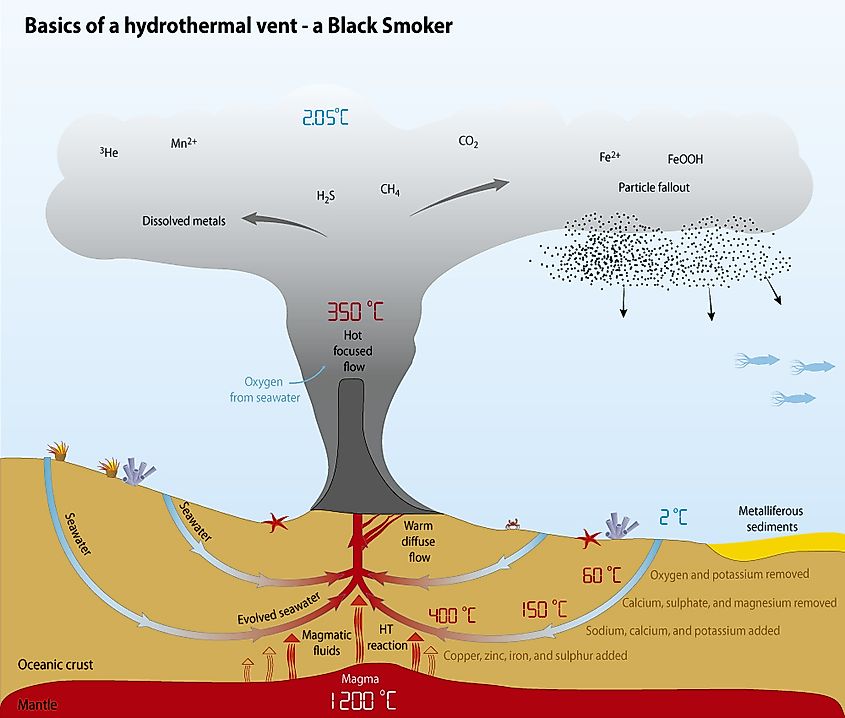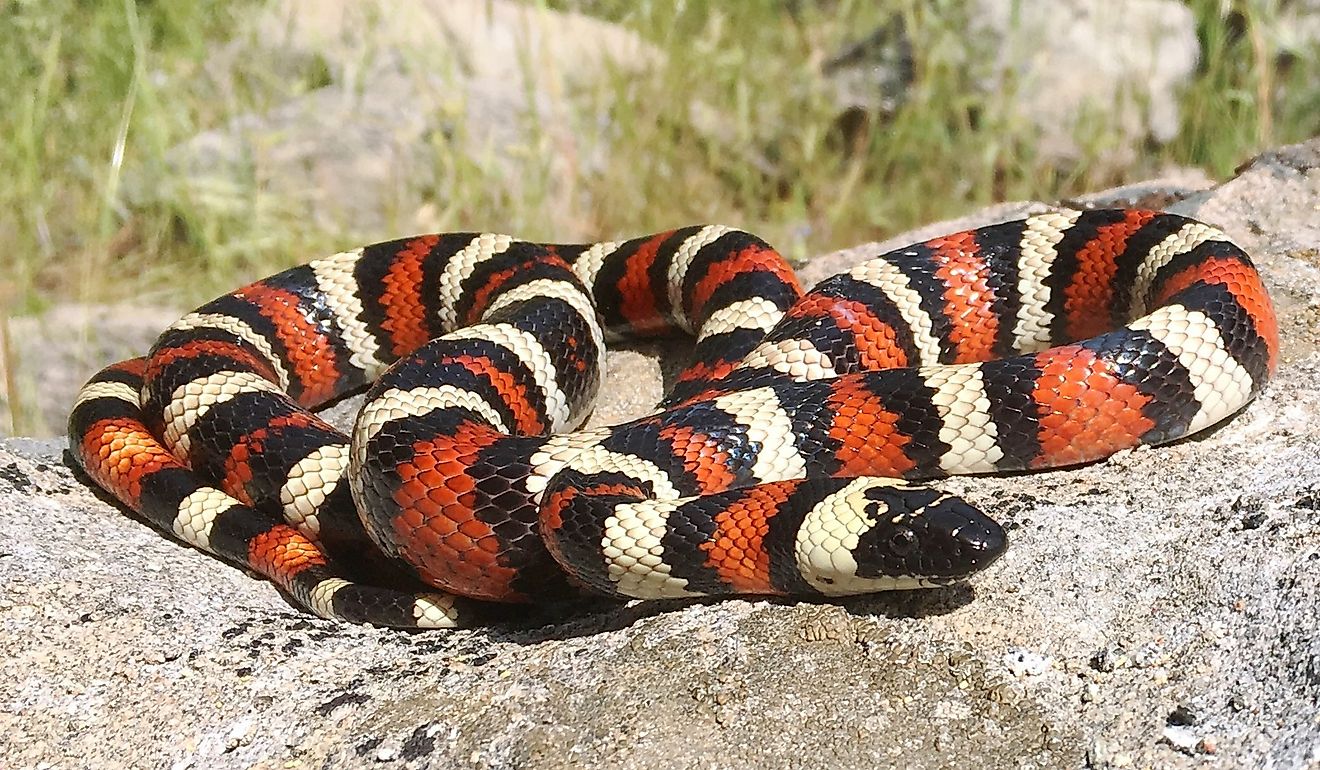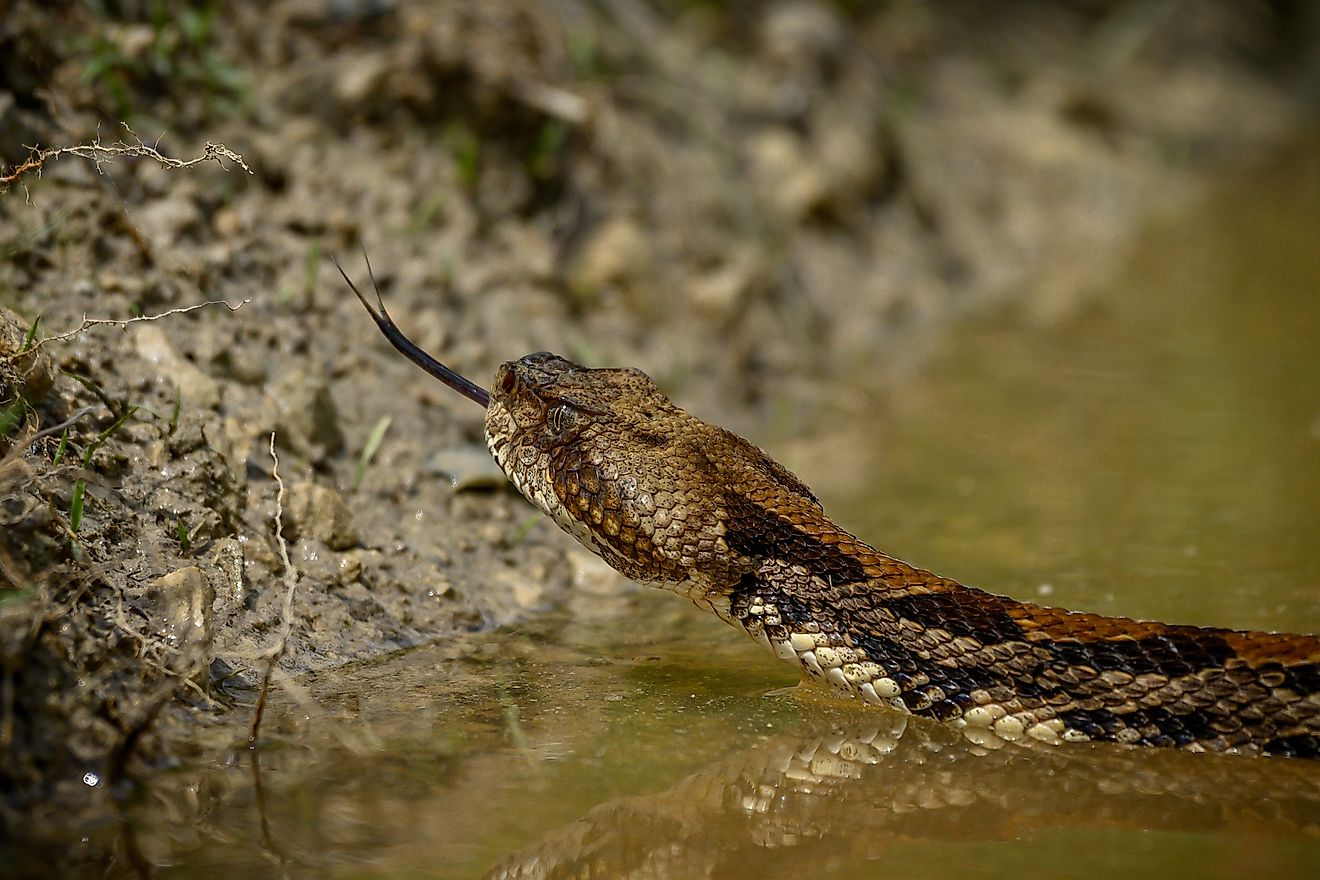
Hydrothermal Vents
Hydrothermal Vents are fissures on the ocean floor from which jets of geothermally heated nutrient-rich seawater is released into the cold deep oceans. These vents are usually found close to mid-ocean ridges where tectonic plates are moving apart at divergent boundaries or at seamounts and island arc volcanoes that are associated with convergent boundaries. Although the Plate Tectonics Theory predicted the existence of these hydrothermal vents, they were discovered only in 1977 and have attracted several groups of researchers since then. Many researchers believe these deep-sea hydrothermal vents hold the key to understanding the origin of life on Earth.
The existence of hydrothermal vents is attributed to the Earth’s geologically active nature and the presence of massive amounts of water both within the crust and on the surface. It has also been recorded that the places around hydrothermal vents are highly productive, harboring groups of complex biological communities sustained by the energy from chemicals dissolved in the vent fluids. Active hydrothermal vents have also been reported in other celestial bodies like Europa - Jupiter's moon, and Enceladus - Saturn's moon.
Geography Of Hydrothermal Vents

The term hydrothermal is composed of two Greek words: ‘Hydor,’ which means ‘water,’ and ‘therme,’ which means ‘heat.’ The term ‘vent’ has been derived from the French word ‘eventer,’ which means ‘to expose to air.’ The water released from the seafloor hydrothermal vents comprises mainly seawater drawn through faults and porous sediments into the hydrothermal system near the volcanic edifices. The water which emerges from the hydrothermal vents has temperatures ranging between 140°F and 867°F. The water also exists as a “supercritical fluid” at such high temperatures due to the extremely high hydrostatic pressure at these depths.
At the mid-oceanic ridges, where the tectonic plates move apart, the crust’s stretching leads to the development of cracks or fissures within it. Cold seawater then percolates through these cracks and seeps more profoundly into the crust, where it comes in contact with the underlying heated mantle. Chemical reactions caused by the superhot magma remove oxygen, sulfates, magnesium, and other chemicals from the seawater. In due course, the fluid becomes hotter and highly acidic, leading it to leach metals like iron, copper, cobalt, zinc, and lead from the adjoining rocks. This heated fluid then rises above the surface through cracks and fissures on the ocean floor. As the heated fluid emerges from the vents, it comes in contact with the cold oxygenated seawater. This leads to another rapid series of chemical reactions where sulfur and other solids precipitate to form metal-rich towers and mineral deposits around the venting fluid on the seafloor.
Where Are Hydrothermal Vents Found?
Hydrothermal vents are mainly observed along the tectonic plate boundaries and also at intra-plate locations like hotspot volcanoes. About 500 active submarine hydrothermal vent fields were identified till 2009, with roughly half of them observed at the seafloor and the other half identified by water column indicators or seafloor deposits. In 2012, a study by Rogers et al. reported the presence of around 11 biogeographic provinces of hydrothermal vent systems. Some of these biogeographic provinces include the Mid-Atlantic Ridge province, Northern East Pacific Rise province, East Scotia Ridge province, Central East Pacific Rise province, Indian Ocean province, Southern East Pacific Rise province, south of the Easter Microplate, and four provinces located in the western Pacific Ocean.
Types Of Hydrothermal Vents
Based on the flow levels of their plumes and an array of physical and chemical factors, hydrothermal vents can be categorized into two distinctive types: black smokers and white smokers.
Black Smokers

Also called deep sea vent, this type of hydrothermal vent is observed on the seabed in the bathypelagic zone as well as deeper in the abyssopelagic zone. The hydrothermal vent bears chimney-like structures that emit superheated water containing high levels of sulfides. When this superheated water comes in contact with the cold ocean water, the dissolved minerals precipitate, creating black-colored chimney-like structures around each vent. In due course, these deposited metal sulfides become volcanogenic massive sulfide ore deposits.
Black smokers were initially discovered on the East Pacific Rise as a part of the RISE Project in 1979. At present, black smokers are known to exist in both the Pacific and Atlantic Oceans at depths of 6,900 ft. The deepest identified black smokers in the world are placed about 3.1 miles below the ocean surface in the Cayman Trough.
White Smokers

This type of hydrothermal vent is found at lower temperatures, quite distant from their magmatic heat sources. The light-colored appearance of this vent type is attributed to the emission of lighter-hued minerals like calcium, silicon, and barium. In comparison to black smokers, white smokers release cooler plumes and form small chimneys.
Discovery And Exploration Of Hydrothermal Vents
A 1949 deep water survey reported unnatural hot brines at the heart of the Red Sea. In the 1960s, some studies established the presence of saline brines and related metalliferous mud having temperatures above 140°F. Scientists believed that these hot solutions were rising from an active subseafloor rift. In June 1976, scientists from California’s Scripps Institution of Oceanography, on a Pleiades II expedition, confirmed the presence of submarine hydrothermal vents along the Galapagos Rift in the East Pacific Rise mid-oceanic ridge. The site was nicknamed “Clam-bake,” and transponders were deployed so an expedition could return for direct observations via a research submersible named DSV Alvin. The first scientific papers describing hydrothermal vents were formally published the following year.
In the same year, a team of marine geologists directly observed chemosynthetic ecosystems encircling the Galapagos Rift submarine hydrothermal vents. In 1979, the research submersible DSV Alvin helped the researchers discover “black smokers” or high-temperature hydrothermal vents emitting black mineral particle jets at the East Pacific Rise. With the help of a temperature probe, the researchers recorded that the deep sea “black smoker” hydrothermal vents have a water temperature of up to 752°F.
In 2005, a mineral exploration company named Neptune Resources NL was granted exploration rights over 35,000 sq. km for exploring seafloor massive sulfide deposits formed from the modern hydrothermal vent fields in the Kermadec Arc region in the Exclusive Economic Zone of New Zealand. In April 2007, the Medusa hydrothermal vent field was discovered offshore Costa Rica in the Pacific Ocean. Until 2010, the 110 km long Ashadze hydrothermal vent field located within the Cayman Trough in the slow-spreading Mid-Cayman Rise was the deepest known high-temperature hydrothermal field. In 2013, the deepest known hydrothermal vents were found at a depth of 16,000 ft in the Caribbean Sea.
Ecology Of Hydrothermal Vents

It has been estimated that the hydrothermal vent zones have an organism density about 10,000 to 100,000 times greater than the surrounding seafloor, as well as a relatively higher degree of species endemism and specializations. As sunlight cannot reach the hydrothermal vents, the exotic biological communities that are found around these vents sustain on nutrients found in the chemical deposits and hydrothermal fluids. Thus, chemosynthetic bacteria which produce energy using chemicals are primary producers of the deep-sea hydrothermal vent ecosystem. Through the process of chemosynthesis, these bacteria utilize sulfur compounds, mainly the toxic hydrogen sulfide, to produce organic materials. The chemosynthetic bacteria attract organisms like copepods and amphipods that feed upon them. Some large organisms, like snails, crabs, tube worms, shrimp, octopuses, and fish like cutthroat eel, tonguefish, eelpouts, etc., form a part of the food chain above the primary consumers.

In addition, various gastropods, crustaceans, large bivalves, pogonophorans, annelids, eyeless shrimps, and vestimentiferan worms are also found. Some notable animals that have been reported from the hydrothermal vents include scaly-foot gastropods, Pompeii worms, giant vent mussels, yeti crabs, O’Shea’s vent barnacles, giant tube worms, etc. Moreover, putative fossilized microorganisms were found in hydrothermal vent precipitates in Canada’s Nuvvuagittuq Greenstone Belt, which are believed to have lived about 4.280 billion years ago.
Conservation Of Hydrothermal Vents
The various mineral deposits that are found at the deep-sea hydrothermal vents, due to their unique physical and chemical conditions, are extremely valuable and are becoming commercially exploitable. Currently, many mineral exploration companies have set their attention on these rich mineral deposits and are trying to extract them from the hydrothermal vent fields. It is believed that this deep-sea mining has the potential to cause severe environmental impacts from the mining machinery, in turn causing the collapse of the vents, underwater landslides, release of gas hydrates, and affecting filter-feeding organisms.
Hydrothermal vents provide valuable insights into the environment and ecological forces that have helped shape life under extreme conditions. A proper understanding of the hydrothermal vent ecosystems is, therefore, necessary to redefine our knowledge of the origins and evolution of life on Earth. Studies of marine genetic resources from hydrothermal vents have led to the development of new medical and industrial applications. The microbial communities found in these vents also play a critical role in the global cycling of important elements. The biochemistry of the chemosynthetic bacteria which these vents harbor might provide significant clues about the nature of chemical reactions that initiated the beginning of life on Earth and the possibility of the presence of life elsewhere in the solar system.











